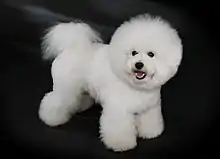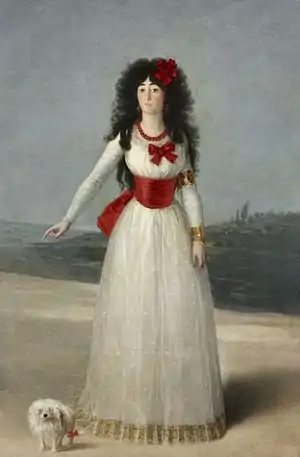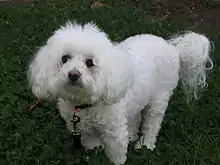Bichon Frise
A Bichon Frise (/ˈbiːʃɒn ˈfriːz/ or /ˈbiːʃɒn frɪˈzeɪ/; from French: bichon à poil frisé, French pronunciation: [biʃɔ̃ fʁize], meaning 'curly lap dog') is a small breed of dog of the bichon type.
| Bichon Frise | |||||||||||||||||||||||||
|---|---|---|---|---|---|---|---|---|---|---|---|---|---|---|---|---|---|---|---|---|---|---|---|---|---|
 | |||||||||||||||||||||||||
| Other names |
| ||||||||||||||||||||||||
| Origin |
| ||||||||||||||||||||||||
| |||||||||||||||||||||||||
| |||||||||||||||||||||||||
| Dog (domestic dog) | |||||||||||||||||||||||||
Etymology

The French word bichon comes from Middle French bichon ('small dog'), a diminutive of Old French biche ('female dog', cognate with English bitch), from Old English bicce, and related to other Germanic words with the same meaning, including Old Norse bikkja, and German Betze.[2][3] Some speculate the origin of bichon to be the result of the apheresis, or shortening, of the word barbichon ('small poodle'), a derivative of barbiche ('shaggy dog'); however, this is likely impossible, since the word bichon (attested 1588) is older than barbichon (attested 1694).[4][5] While the English name for the breed, Bichon Frise, is derived from the French bichon à poil frisé meaning 'curly lap dog', the usual English spelling does not include the diacritic(Bichon Frise instead of Bichon Frisé).[6]
History
The Bichon Frise is often depicted as a French dog. Although the Bichon breed type are originally Spanish, used as sailing dogs, also as herding dogs sometimes, the French developed them into a gentle lap-dog variety. The Bichon type arose from the water dogs, and is descended from the poodle-type dogs and either the Barbet or one of the water spaniel class of breeds. Modern Bichons have developed into four categories: the Bichon Frise or Tenerife, the Maltese, the Bolognese, and the Havanese. These are often treated as separate breeds.[7]
Because of their merry disposition, the ancestral Bichons travelled much and were often used as barter by Italian sailors as they moved from continent to continent.[8] The dogs found early success in Spain and it is generally believed that Spanish seamen introduced the early breed to Tenerife in the Canary Islands. In the 14th century, Italian sailors rediscovered the dogs on their voyages and are credited with returning them to continental Europe,[9] where they became great favorites of Italian nobility. As was the style with dogs in the courts, their coats were cut "lion style", like a modern-day Portuguese Water Dog.

The Tenerife, often simply called the Bichon, had success in France during the Renaissance under Francis I (1515–1547), but its popularity increased in the court of Henry III (1574–1589), when it had become popular amongst French nobility as both a court companion and lap dog.[11] The breed also enjoyed considerable success in Spain as a favorite of the Infantas, and were often included in portraits of royalty. In particular, Francisco de Goya included Bichons in several of his works.
Interest in the breed was renewed during the rule of Napoleon III, but then waned until the late 19th century when it became the "common dog," running the streets, accompanying the organ grinders of Barbary, leading the blind, and doing tricks in circuses and fairs.[12] After World War I, they had begun to become popular again in France and were bred by French breeders.[13][14]
On 5 March 1933, the official standard of the breed was adopted by the Société Centrale Canine, the national kennel club for France.[15] This was largely due to the success of the French-speaking Belgian author Hergé's The Adventures of Tintin, which featured a small, fluffy, white fox terrier dog named Milou (translated to Snowy in the English editions). As the breed was known by two names at that time, the Tenerife and the Bichon, the president of the Fédération Cynologique Internationale proposed a name based on the characteristics that the dogs presented – the Bichon À Poil Frisé, later shortened to Bichon Frisé. On 18 October 1934, the Bichon Frisé was admitted to the stud book of the Société Centrale Canine.
The Bichon was brought to the United States in 1955.[16] The first US-born Bichon litter was whelped in 1956. In 1959 and 1960, two breeders in different parts of the US acquired Bichons, which provided the origins for the breed's further development in that country.
The Bichon Frise became eligible to enter the AKC's Miscellaneous Class on 1 September 1971. In October 1972, the breed was admitted to registration in the American Kennel Club Stud Book. On 4 April 1973, the breed became eligible to show in the Non-Sporting Group at AKC dog shows. In 2001, a Bichon Frise named J.R. won best-in-show at the Westminster Kennel Club Dog Show. In the United States, the Bichon Frise was ranked the 40th most popular breed in 2013 according to the American Kennel Club.[17]
The Bichon was introduced into Australia in the 1970s and since its introduction has proved successful as both a show and companion dog.[18]
Description
Appearance

The Bichon Frise is a small dog that weighs approximately 5–10 kg (10–20 lbs) and stands 23–30 cm (9–12 in) at the withers, but slightly larger dogs are not uncommon. The skull is slightly rounded and the muzzle is not pointy. The tail is groomed to be long and curly and is carried over the back. It has a black nose and dark round eyes; its white hair consists of a curly, dense coat with little shedding (much like a poodle in this respect), although many of the breed do tend to have less curly hair than others. A small amount of buff, cream, or apricot colour may be seen around its ears, snout, paws or body, but normally these colours do not exceed 10% of its body. FCI/AKC Standard coat colour is pure white; other colours such as apricot or grey and brown are not recognised. A white coat is preferred in the show ring. The head and legs are proportionate in size to the body, and the ears and tail are natural (not docked or cropped).[19] The coat is trimmed often to make the hair seem like an even length. Bichon Frises have a medium-high intelligence.
Temperament
The American Kennel Club refers to the Bichon Frise as "merry" and "curious,"[16] and the breed standard calls for a dog that is "gentle mannered, sensitive, playful and affectionate." The dogs are generally very sociable and do well with an owner who takes them along on outings, and are affectionate and intelligent. If affiliated with a particular territory and encouraged by owners, they can become very territorial.[20] Developed as a companion-dog breed, the Bichon Frise tends to get along well with both children and other animals. Bichon Frises are very obedient if training is started early and continued constantly.

Though not considered a retriever or a water dog by modern standards, the Bichon type, due to their ancestry as sailors' dogs, have an affinity for water and enjoy retrieving. On the boats, however, the animals' role was that of companion dog.
Grooming

Bichon Frises have coats that require a diligent grooming schedule. Grooming helps remove loose hair, and the curl in the coat helps prevent dead hair and dander from escaping into the environment, as with the poodle's coat.[21] The coat is combed to remove loose hair, mats, and tangles. Bichon Frises may need grooming approximately every four to eight weeks. This breed tends to have hair growing within the ear canals, that if not plucked regularly, can trap moisture, bacteria, and yeast, creating an unbalanced microbiome in the ear. This may lead to excessive head shaking, causing an ear hematoma. As Bichon Frises are white dogs, frequent bathing is required to maintain the colour.
Bichon Frises are considered to be hypoallergenic as they do not readily shed (moult)[22][23] and are thus generally suitable for people with allergies.[24] It is important to note that human sensitivity to dog fur, dander, and saliva varies considerably. Although hair, dander, and saliva can be minimised, they are still present and can stick to "clothes and the carpets and furnishings in your home." Inhaling the allergens, or being licked by the dog, can trigger a reaction in a sensitive person.[25]
Lifespan
Bichon Frises in the UK, the United States, and Canada (according to surveys of their owners) have an average life span of about 12–13 years or older, with Bichon Frises in the UK tending to live longer than Bichon Frises in North America, though the record age was lower in the UK.[26] This breed's longevity is similar to other breeds of its size, and somewhat longer than purebred dogs in general.[27]
The longest-lived of 34 deceased Bichons in a 2004 UK survey died at 16.5 years.[28] The oldest Bichon Frises for which there are reliable records in various North American surveys have died at 21 years.[29]
In a 2004 UK Kennel Club survey, the leading causes of Bichon Frise death were old age (23.5%) and cancer (21%).[28] In a 2007 US/Canadian breeders survey, the leading causes of death were cancer (22%), unknown causes (14%), hematologic (11%), and old age (10%).[29] Hematologic causes of death were divided between autoimmune hemolytic anemia (AIHA) and immune-mediated thrombocytopenia (ITP). AIHA and ITP were responsible for the greatest number of Bichon Frise "years lost" (a measure of the extent to which a condition kills members of a breed prematurely). While cancer is a more common cause of death than AIHA and ITP, Bichon Frises that died of cancer died at a median age of 12.5 years.[29] Hematologic deaths occurred at a median age of only five years. Bichon Frises in the UK survey had a lower rate of hematologic deaths (3%) than in the USA/Canada survey (11%).[28]
Health concerns
Bichon Frises are prone to scratching and chewing on themselves in the summer because of the warm and moist air, which commonly results in serious skin conditions. They are comparatively hypoallergenic, but they themselves suffer from allergies to fleas, ticks, chemicals, pollen, dust, etc. Loose knee joints, ear infections, cataracts, diabetes, and heart disease are also common.[30]
Bichons are also prone to liver shunts. These often go undetected until later in life, leading to complications that cannot be addressed, and therefore liver failure. Bichons who are underweight, runts of the litter, or have negative reactions to foods high in protein are more likely to be suffering from a shunt. When detected early, shunt often can be corrected through surgery. However, the later in life the shunt is detected, the lower the likelihood of surgery being successful. Shunts can be kept under control through special low-protein diets and through medications to support liver function, help flush toxins that build up in the kidneys and liver, and control seizures that often occur as a symptom of the shunt. Without surgery, Bichons with shunts on average live to be 4–6 years old. Other symptoms include dark urine, lethargy, loss of appetite, and increased thirst. Seizures come in all forms; episodes of seizures can begin early in life but may go undetected. Early seizures can appear as a hypnotic state or an episode of vertigo.
AIHA and ITP
Autoimmune hemolytic anemia (AIHA, also called immune-mediated hemolytic anemia, or IMHA) and immune-mediated thrombocytopenia (ITP) are responsible for many premature Bichon Frise deaths. These diseases can strike with little or no warning and kill very quickly. In AIHA, the dog's immune system attacks its own red blood cells, leading to severe, life-threatening anemia. Symptoms include weakness, loss of energy, lack of appetite, vomiting, diarrhea, rapid heart rate, rapid breathing, dark urine, and pale or yellow gums.[31]
ITP often accompanies AIHA.[32] In ITP, blood platelets (which cause blood clotting) are destroyed. The most common clinical signs are haemorrhages of the skin and mucus membranes.[32] Mortality rates of 20% to 80% are reported.[31]
References
- "Bichon Frise". Purebredpups.org. Retrieved 11 December 2017.
- Auguste Scheler, Dictionnaire d'étymologie française d'après les résultats de la science moderne, "bichon".
- Donkin, Diez, An etymological dictionary of the Romance languages, "biche".
- Centre National de Ressources Textuelles et Lexicales, "bichon".
- "French etymology of barbiche". myEtymology.com. Retrieved 10 October 2012.
- "Bichon Frise Dog Breed Information". Akc.org. Retrieved 11 December 2017.
- Stregowski, Jenny. "Bichon Frise: Dog Breed Profile". sprucepets.com.
- "11 Fluffy Facts About the Bichon Frise". mentalfloss.com.
- "History of the Bichon Frise". bichon.org.
- "María Cayetana de Silva, 13th Duchess of Alba", Art Hive, 2 December 2020, retrieved 8 December 2020https://arthive.com/publications/3743~Love_Story_in_Paintings_Francisco_Goya_and_Mara_Cayetana_de_Silva_the_Duchess_of_Alba
- "Bichon Frise Breed Information - All You Need To Know".
- "Bichon Frise". purina.com.au.
- "Bichon Frise". britannica.com.
- "Bichon Frise: Henry III's Favorite Pet Dog". smartfarmzone.com.
- "Bichon Frise Page". AKC.org. American Kennel Club. 2012. Retrieved 10 October 2012.
- "Get to Know the Bichon Frise", The American Kennel Club, Retrieved 30 April 2014
- "2013 Dog Registration Statistics Historical Comparisons & Notable Trends". AKC.org. American Kennel Club. 2014. Retrieved 30 April 2014.
- "Bichon Frise". pedigree.com.
- "FCI-Standard No. 215: Bichon Frise (Bichon à poil frisé)". FCI.be. Fédération Cynologique Internationale. 11 May 1998. Archived from the original on 31 August 2012. Retrieved 20 February 2018.
- "Meet the Breeds: Bichon Frise". AKC.org. American Kennel Club. 2012. Retrieved 10 October 2012.
- "Hair vs Fur". Dogplay.com. Retrieved 10 October 2012.
- "Dogs that do not shed – Retrieved 7 September 2008". Go Pets America. 25 July 2010. Archived from the original on 30 September 2018. Retrieved 10 October 2012.
- "Top 15 Hypoallergenic Dog Breeds". dogmal.com.
- "Dogs and Allergies". AKC.org. American Kennel Club. 2012. Retrieved 10 October 2012.
- "Pet allergy – Symptoms and causes". MayoClinic.com. Mayo Clinic. Retrieved 11 December 2017.
- Cassidy, Kelly M., ed. (1 February 2008). "Breed Longevity Data". Dog Longevity. Retrieved 20 February 2018.
- Cassidy, Kelly M., ed. (26 December 2007). "Survey Comparisons". Dog Longevity. Retrieved 20 February 2018.
- "Purebred Dog Health Survey Results". TheKennelClub.org.uk. The Kennel Club. Retrieved 5 July 2007.
- "Surveys and Reports". BichonHealth.org. Bichon Frise Club of America. 2013. Archived from the original on 19 March 2013. Retrieved 20 February 2018.
- "Bichon Frise Club of America - Health Resource Center - Health Articles". Bichonhealth.org. Archived from the original on 6 November 2017. Retrieved 11 December 2017.
- McDonald, Nancy (2013). "Immune Mediated Hemolytic Anemia". BichonHealth.org. Bichon Frise Club of America. Archived from the original on 28 September 2007. Retrieved 20 February 2018.
- Merck Veterinary Manual online. Immune System chapter, Immunopathologic diseases section. Last accessed 18 August 2007
Bernedoodle Breed Information and History by The Dogs Lover